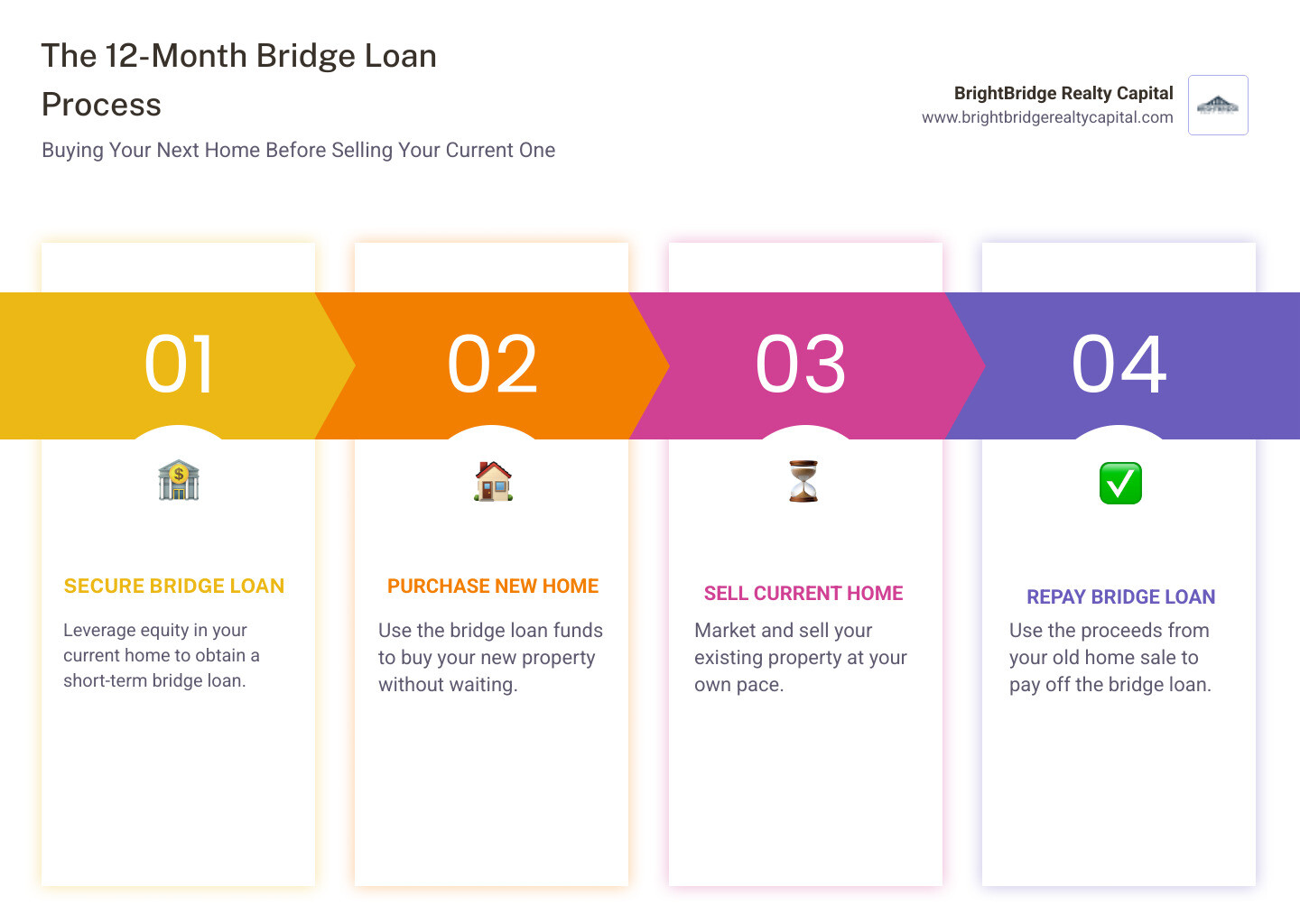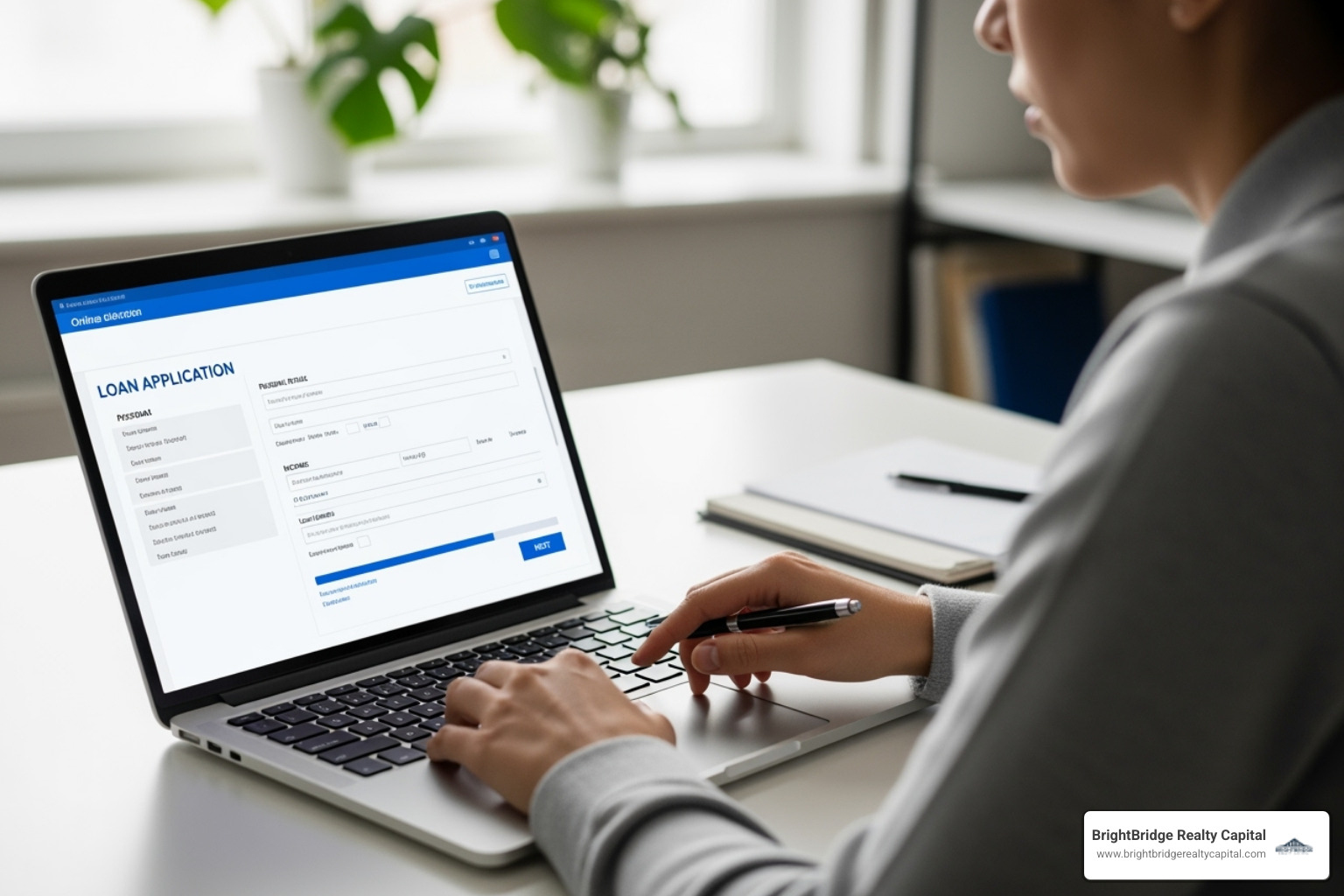Navigating the Waters: What to Know About 12-Month Bridge Loans

What Is a 12-Month Bridge Loan and When Is It Used?
A 12 month bridge loan is a specialized, short-term financing instrument carefully designed to provide rapid, temporary funding. Its primary function is to "bridge" a financial gap, a common scenario in real estate where immediate capital is required to secure a new opportunity before long-term funding or proceeds from a sale become available. Think of it as a financial causeway that connects your current financial position to your future, more liquid state. For a foundational understanding of this financial tool, the Wikipedia page on Bridge loans offers a general overview.
- Core Purpose: The most common use is to facilitate the purchase of a new property before the sale of an existing one is finalized.
- Typical Term: As the name suggests, the loan term is structured for up to 12 months, providing a balance of urgency and flexibility.
- Strategic Benefit: In the world of real estate, speed is a currency. A bridge loan empowers you to act decisively on opportunities, avoiding costly delays and strengthening your negotiating position.
In real estate transactions, timing is not just important; it is often the single most critical factor. A 12 month bridge loan serves as a powerful strategic tool, enabling a buyer to open up the equity tied up in their current property to make an immediate, compelling offer on a new one. This eliminates the need for a sale contingency, which can be a deal-breaker in a competitive market. Also known by terms like "gap financing," a "swing loan," or "interim financing," it provides a crucial financial lifeline during a period of transition.

Basic 12 month bridge loan vocab:
How It Differs from Other Bridge Loan Terms
While all bridge loans are, by definition, short-term, the specific length of the term can vary significantly, typically from six months to three years. A 12 month bridge loan is often considered the "sweet spot," striking an optimal balance between pressure and cost.
Shorter Terms (e.g., 6 months): These loans are designed for transactions expected to resolve very quickly. They are ideal for a property that is already under contract or for a fix-and-flip project with a pre-identified buyer. However, they come with immense pressure. Any unexpected delay in the sale, renovation, or refinancing process can put the borrower in a precarious financial position, potentially leading to costly extension fees or even default.
Longer Terms (e.g., 24-36 months): These are better suited for more complex, large-scale projects. This could include ground-up construction, significant renovations requiring zoning changes, or stabilizing a commercial property with multiple tenants. While the extended timeframe offers more breathing room, it comes at a significant cost. The longer interest accrues, the higher the total cost of borrowing, which can eat into the profitability of an investment.
The 12-Month Advantage: This term length provides a generous yet disciplined timeframe. It is long enough to comfortably market and sell an existing property without succumbing to lowball offers. It allows sufficient time for most renovation projects that improve a property's value. Crucially, it gives borrowers the space to secure favorable long-term financing without the frantic rush associated with shorter terms or the excessive cost of longer ones. This balance makes it a versatile and popular choice for a wide range of scenarios.
Deep Dive: Common Scenarios for a 12-Month Bridge Loan
A 12 month bridge loan is not a one-size-fits-all solution, but its flexibility makes it suitable for several key situations. Here are more detailed explorations of its common applications:
Homeowners Buying Before Selling: Consider a family that finds their dream home in a competitive school district. The seller has multiple offers. By using a 12-month bridge loan, the family can tap into the equity of their current home to make a strong, non-contingent cash offer. This makes their bid far more attractive than offers that depend on the sale of another property. They secure their new home and then have up to a year to sell their old one at a good price, without the stress of managing two simultaneous closings.
Real Estate Investors (Fix-and-Flip): An experienced investor identifies an undervalued property that requires significant cosmetic and structural updates. Traditional lenders won't finance it in its current state. The investor uses a 12-month bridge loan to acquire the property quickly. The 12-month term provides ample time to complete the renovations (e.g., 3-6 months), market the property effectively (1-3 months), and close the sale for a substantial profit (1-2 months), with a built-in buffer for unexpected delays.
Business Owners Needing Capital: A successful manufacturing company needs to expand into a larger warehouse to meet growing demand. Their capital is tied up in inventory and receivables. A 12-month bridge loan allows them to purchase the new facility immediately, securing it before a competitor does. This gives them the time to transition operations and then secure a long-term commercial mortgage or sell their old, smaller facility to repay the bridge loan.
Acquiring Distressed Properties at a Discount: A bridge loan is often the only tool for purchasing properties that are bank-owned (REO), in foreclosure, or being sold at auction. These sales often require cash and a very fast closing (sometimes within 10-15 days). A 12-month bridge loan provides the necessary quick capital to secure the property at a discount. The investor then has a year to renovate the property, resolve any title issues, and either sell it or refinance it with a traditional lender once it's in a financeable condition.
For more specific guidance custom to your situation, explore our dedicated resources for Real Estate Investors and Homeowners.
Unpacking the Advantages of a 12-Month Term
Choosing a 12 month bridge loan open ups several powerful benefits that can make or break a real estate transaction:
- Best Speed of Funding: In markets where properties receive offers within days of listing, the ability to close in as little as a week is a superpower. This speed, a hallmark of bridge lending, is crucial for time-sensitive opportunities.
- Eliminating Contingencies for a Stronger Offer: A non-contingent offer tells a seller you are serious and capable. It often allows you to win a bidding war even if your offer isn't the absolute highest price, as it represents certainty and a faster, smoother closing.
- Sufficient Time for Value-Add Renovations: A 12-month window is a comfortable and realistic timeframe for completing renovations that can significantly increase your property's market value and, therefore, your profit margin upon sale or equity position for refinancing.
- Reduced Pressure to Sell: With a year-long runway, you are not forced into a quick, desperate sale of your existing property. You have the time to properly stage and market the property, wait for the right buyer, and negotiate from a position of strength, avoiding lowball offers.
- Improved Payment Flexibility: The structure of many bridge loans, particularly the interest-only payment model, significantly eases the monthly financial burden during the loan term. This frees up capital that can be used for renovations, moving costs, or other expenses, improving overall cash flow management during a transitional period.
Dive deeper into the Benefits of a 12-Month Bridge Loan to learn more.
How a 12-Month Bridge Loan Works: Costs, Terms, and Repayment
Understanding the intricate financial mechanics of a 12 month bridge loan is absolutely essential before proceeding. While these loans offer unparalleled speed and flexibility, their cost structure is fundamentally different from that of a traditional mortgage. This premium is the price for convenience, speed, and the ability to access capital for urgent needs. For a comprehensive look, please see our Overview of Bridge Loan Financing.
A Detailed Breakdown of Interest Rates and Fees
Bridge loans command higher interest rates and fees than long-term mortgages because they represent a higher risk to the lender and are designed for short-term, strategic use.
Interest rates for a 12 month bridge loan typically fall within a range of 6% to 12%, with most loans clustering between 7% and 10%. These rates are influenced by several factors, including the borrower's credit profile, the loan-to-value (LTV) ratio, and the specific characteristics of the property. Rates can be fixed for the term of the loan, providing predictability, or they can be floating (variable), tied to a benchmark index like the prime rate. A floating rate might start lower but carries the risk of increasing over the 12-month term.
Beyond the interest rate, borrowers must budget for several standard financing fees:
- Origination Fees: This is a fee charged by the lender for processing and setting up the loan. It is typically calculated as a percentage of the total loan amount, usually ranging from 1% to 3%. For a $500,000 loan, this could be between $5,000 and $15,000.
- Closing Costs: Similar to a traditional mortgage, these costs cover the various third-party services required to finalize the loan. They can include appraisal fees, title insurance policies, escrow fees, notary fees, and legal review fees. These costs generally add up to 1.5% to 3% of the loan amount.
- Other Potential Fees: Depending on the lender, you might encounter other charges. These can include underwriting fees, processing fees, wire transfer fees, or an exit fee (a charge for repaying the loan). Some lenders may also charge extension fees if you need more time beyond the initial 12 months, or prepayment penalties if you pay the loan off too early, though these are less common on our loans.
At BrightBridge Realty Capital, we are committed to full transparency. We provide a detailed term sheet upfront that clearly itemizes all costs and fees, so there are no surprises at closing. For more granular detail, please consult our guides on 12-Month Bridge Loan Interest Rates and Fees.
The Repayment Structure and the All-Important Exit Strategy
The repayment of a 12 month bridge loan is structured for maximum cash flow during the loan term. For the majority of the 12 months, the borrower is typically required to make interest-only payments. This keeps the monthly outlay low, preserving capital for renovations, carrying costs, or other needs.
However, this structure culminates in a balloon payment at the end of the 12-month term, where the entire original principal balance becomes due in one lump sum. This feature makes having a clear, viable, and well-vetted exit strategy the single most critical component of a successful bridge loan. Your exit strategy is your documented plan for repaying the loan in full. The most common exit strategies include:
- Sale of an Existing Property: This is the classic exit for homeowners. The proceeds from the sale of their current home are used to pay off the bridge loan balance. A successful strategy involves pricing the home correctly and marketing it effectively to ensure a sale within the 12-month window.
- Refinancing into a Permanent Mortgage: This is a common strategy for real estate investors. After acquiring and renovating a property with a bridge loan, they refinance with a long-term mortgage (like a 30-year fixed loan) to hold the property as a rental. The new loan pays off the bridge loan, and the investor benefits from the property's increased value and rental income.
- Securing Other Long-Term Financing: For commercial properties or businesses, the exit might involve obtaining a traditional commercial loan, an SBA loan, or another form of business financing once the company's financial situation has stabilized or the new property is operational.
A solid, realistic repayment plan is the bedrock of a successful bridge loan experience. Learn more in our detailed guide to 12-Month Bridge Loan Repayment.
What Happens if You Can't Repay in Time?
Even the most carefully laid plans can encounter unforeseen delays—a renovation takes longer than expected, a buyer's financing falls through, or market conditions shift. If you anticipate being unable to repay the 12 month bridge loan on time, the most important step is to contact your lender immediately. Proactive communication is key.
In many cases, lenders prefer to work with borrowers to find a solution. One common option is a loan extension. This typically involves paying an extension fee and may come with a higher interest rate for the extended period, but it provides valuable extra time to execute your exit strategy. Another possibility is refinancing into another short-term loan if a long-term solution isn't yet viable.
However, borrowers must be aware of the serious risks. The loan is secured by your real estate. Failure to pay will result in default. A default can severely damage your credit score and your ability to secure financing in the future. In a worst-case scenario, the lender has the right to initiate foreclosure proceedings to seize and sell the collateral property to recoup their investment. It's critical to remember that many bridge loans, especially those for investment purposes, lack some of the consumer protections afforded to traditional mortgages, making a clear exit plan and open communication with your lender absolutely paramount.
How to Qualify and Apply for a Bridge Loan

Securing approval for a 12 month bridge loan follows a different path than qualifying for a traditional mortgage. Bridge lenders place a greater emphasis on the value of the underlying real estate asset and the strength of your exit strategy, rather than focusing solely on perfect credit and income documentation.
At BrightBridge Realty Capital, we have engineered our process to be direct and efficient because we understand that time is of the essence. We eliminate unnecessary red tape and concentrate on the factors that truly matter for a successful short-term loan. Learn more about our streamlined approach to Applying for a 12-Month Bridge Loan.
A Deep Dive into Eligibility Requirements
When we review your application, our underwriting team performs a holistic assessment, focusing on these key areas:
- Significant Home Equity: The property you use as collateral must have substantial equity. This equity is the lender's security. Typically, you'll need at least 15-20% equity, but the more equity you have, the stronger your application and the more borrowing power you will possess.
- Loan-to-Value (LTV) Ratio: This is a critical metric. We calculate it by dividing the requested loan amount by the property's appraised market value. We generally offer loans up to a maximum LTV of 80%. For example, on a property appraised at $1,000,000, we could lend up to $800,000. A lower LTV represents lower risk for the lender and can result in better loan terms for the borrower.
- Debt-to-Income (DTI) Ratio: While traditional lenders have strict DTI limits (often below 43%), bridge lenders are more flexible. We understand that you may be carrying multiple mortgages temporarily. We can often work with DTI ratios up to 50% or sometimes even higher, provided you have significant liquid assets and a very strong, well-documented exit strategy.
- Credit Scores: A strong credit history is always beneficial. A FICO score of 700 or higher will typically secure the best interest rates and terms. However, a lower score is not necessarily a deal-breaker. We take a common-sense approach; a valuable property with a low LTV and a clear path to repayment can often compensate for a less-than-perfect credit score.
- Verifiable Property Value: The collateral property is the cornerstone of the loan. We will require a professional appraisal to determine its current, fair market value. For fix-and-flip projects, the appraisal may include both an "as-is" value and an "after-repair value" (ARV) to assess the project's potential.
- A Coherent Exit Strategy: You must be able to clearly articulate and document your plan for repaying the loan. This isn't just an idea; it should be a concrete plan with realistic timelines and supporting evidence (e.g., a market analysis for the sale of your home, a term sheet from a potential refinancing lender).
Our comprehensive guide on How to Qualify for a 12-Month Bridge Loan provides even more detail on each of these requirements.
The Application and Funding Process: A Step-by-Step Guide
BrightBridge Realty Capital has refined our process to ensure a smooth and rapid journey from initial inquiry to funding.
- Initial Consultation and Pre-Approval: The process begins with a conversation. We'll discuss your specific scenario, the property you're buying, the property you're using as collateral, and your proposed exit strategy. Based on this initial information, we can often provide a pre-approval and a preliminary term sheet within 24 hours.
- Formal Application and Document Submission: Once you decide to proceed, you'll complete a formal application. We will provide a clear checklist of necessary documents, which may include personal financial statements, bank statements, entity documents (if borrowing as an LLC or corporation), the purchase contract for the new property, and details on the collateral property.
- Appraisal and Underwriting: As direct lenders, we control the underwriting process in-house. We will order a rush appraisal on the collateral property. Simultaneously, our underwriting team will review your documentation, verify the information, and perform due diligence on the property's title and your exit plan. Our focus is on the asset's value and your clear path to repayment.
- Loan Commitment and Closing: Once underwriting is complete and the appraisal is approved, we issue a formal loan commitment. Our closing department will then work with you and the title company to schedule the closing. We pride ourselves on clear communication, ensuring you understand all terms and figures before you sign.
- Funding: Our direct lending model allows for an exceptionally fast funding timeline. In many cases, we can get you from a completed application to having funds wired in just one to two weeks. This speed cuts through the typical bureaucratic delays, ensuring you don't miss your critical real estate opportunity.
Comparing Your Options: 12-Month Bridge Loans vs. Other Bridge Loan Solutions
A 12 month bridge loan is an incredibly effective financial tool, but its true value is best understood when compared against other available financing solutions. Each option has a distinct profile, and choosing the right one depends entirely on your specific timeline, risk tolerance, and financial goals. This comprehensive overview illustrates where a 12 month bridge loan excels.
| Feature | 12-Month Bridge Loan | Shorter-Term Bridge Loan (e.g., 6 months) | Longer-Term Bridge Loan (e.g., 24-36 months) | Home Equity Line of Credit (HELOC) | Home Equity Loan | Traditional Mortgage (for new purchase) |
|---|---|---|---|---|---|---|
| Loan Term | 12 months | 3-6 months | 18-36 months | Revolving, 10-year draw, 20-year repayment | Fixed, 10-30 years | Fixed, 10-30 years |
| Interest Rate | Higher than traditional, moderate for bridge loans | Possibly slightly lower, but more pressure | Higher than 12-month due to longer term/risk | Variable, often lower than bridge loan initially | Fixed, comparable to traditional mortgage rates | Lowest rates, fixed or variable |
| Funding Speed | Very Fast (often 1-2 weeks) | Very Fast (often 1-2 weeks) | Fast (2-3 weeks) | Medium (3-6 weeks) | Medium (3-6 weeks) | Slow (45-60+ days) |
| Repayment | Interest-only, balloon payment at maturity | Interest-only, balloon payment at maturity | Interest-only, balloon payment at maturity | Interest-only during draw, then P&I | Fixed Principal & Interest (P&I) payments | Fixed P&I payments |
| Best For | Home purchase before sale, moderate renovations, investor flips | Very quick property sales, minimal renovations, auction purchases | Extensive renovations, ground-up construction, complex projects | Flexible ongoing access to equity, home improvements, debt consolidation | Lump sum for a specific purpose (e.g., debt), lower rates | Long-term home ownership, primary residence financing |
| Key Risk | Failed exit strategy leading to balloon payment issue | Extreme time pressure, any delay is critical | High total interest cost, market fluctuation over longer term | Variable rate can increase significantly, line can be frozen | Reduces home equity with a fixed payment obligation | Slow process can cause you to lose the deal |
Key Differences: 12-Month Bridge Loan vs. Other Bridge Loan Terms
The primary differentiator among bridge loans is the term length, which directly influences the cost, pressure, and strategic application for the borrower.
Timeline and Purpose: A 12-month term is the versatile middle ground. It provides ample breathing room for the unexpected, which is common in real estate. Shorter terms (3-6 months) are surgical tools for when an exit is already highly certain and imminent; they create immense pressure to perform quickly. Longer terms (24-36 months) are for marathon projects, not sprints, and the higher total interest paid reflects this extended timeline. A 12 month bridge loan offers a balanced framework, giving homeowners and investors a realistic yet disciplined timeframe to execute their plan without incurring unnecessary costs or stress.
Interest Rates and Protections: While all bridge loans carry higher rates than traditional mortgages to compensate the lender for speed and risk, a 12 month bridge loan often represents the most cost-effective balance. It's also crucial to understand the regulatory environment. Many bridge loans for investment purposes are considered commercial loans and lack the extensive consumer protections (like mandatory waiting periods or ability-to-repay rules) found in conventional mortgages. This makes it imperative to work with a reputable lender and review all terms and fees carefully.
When NOT to Use a 12-Month Bridge Loan
Understanding when this tool is inappropriate is just as important as knowing when to use it. A bridge loan is not the right choice if:
- You Lack a Clear and Viable Exit Strategy: If your plan to repay the loan is based on hope rather than a concrete, data-backed strategy, the risk of default is too high.
- You Have Insufficient Equity: If your LTV is too high, you won't qualify, and attempting to stretch your finances is unwise.
- Your Timeline is Not Urgent: If you can wait to sell your current home before buying a new one, a traditional mortgage will be significantly cheaper.
- You Are Highly Risk-Averse: The nature of a bridge loan, with its higher costs and balloon payment, involves a level of calculated risk that may not be suitable for every financial personality.
For a more detailed analysis, see our guide on 12-Month Bridge Loan vs. Other Bridge Loan Terms.
Tailoring Your Bridge Loan Solution
At BrightBridge Realty Capital, we reject the one-size-fits-all mentality. We specialize in creating custom real estate financing solutions that are precisely aligned with your specific project, timeline, and financial situation.
We will collaborate with you to structure a 12 month bridge loan with terms that support your needs and a viable exit strategy. As direct lenders, we have the flexibility to offer competitive rates and a seamless, transparent process that ensures you get the right financing quickly and efficiently. If you need a strategic partner who can tailor a solution for you, we are here to help. Consult with BrightBridge Realty Capital for custom solutions.
Frequently Asked Questions about 12-Month Bridge Loans
Here are detailed answers to the most common questions we receive from clients considering a 12 month bridge loan.
Can a 12-month bridge loan be used for new construction?
Absolutely. A 12 month bridge loan is an excellent financial tool for funding new construction or major renovation projects. It is often used to acquire the land and cover the initial "soft" costs (permits, architectural plans) and "hard" costs (excavation, foundation). It effectively bridges the financial gap from the start of the project until the property is substantially complete and qualifies for permanent, long-term construction financing or a traditional mortgage.
For larger projects, these loans can be structured with draw schedules. This means funds are not disbursed as a single lump sum. Instead, capital is released in stages as you complete specific construction milestones (e.g., foundation poured, framing complete, roof on). Each draw requires an inspection to verify progress, which protects both the borrower and the lender. Once the project is finished, the bridge loan is typically paid off by refinancing into a permanent mortgage or by selling the newly constructed property.
What are the biggest risks of taking out a bridge loan?
While powerful, a 12 month bridge loan is a high-stakes financial instrument. It's crucial to fully understand and mitigate the inherent risks:
- Dual Housing Payments: For homeowners, the most immediate financial strain is potentially covering three payments at once: the mortgage on your old home, the interest-only payment on the bridge loan, and the mortgage on your new home. This can significantly impact your monthly budget and requires careful financial planning.
- Higher Costs: The convenience of speed comes at a price. Bridge loans have higher interest rates and origination fees than traditional mortgages. If your exit strategy is delayed, these costs can accumulate rapidly and eat into your profits or equity.
- Failed Exit Strategy: This is the most significant risk. If your existing property doesn't sell within the 12-month term, or if you are unable to secure permanent financing due to credit issues, job loss, or changing lender guidelines, you could face a crisis when the final balloon payment comes due.
- Market Risk: Real estate markets can change. If property values decline during your 12-month term, the sale price of your existing home might be less than anticipated, potentially leaving a shortfall after paying off the bridge loan. For investors, a market downturn could erase their projected profit margin.
- Foreclosure Risk: This is the ultimate consequence. Because the loan is secured by your real estate, a failure to repay the loan according to its terms constitutes a default, which gives the lender the legal right to begin foreclosure proceedings to seize and sell the property to recover their funds.
How quickly can you get a 12-month bridge loan?
Speed is the primary competitive advantage of a 12 month bridge loan. While a traditional mortgage application process can easily take 45 to 60 days or more, a bridge loan from a direct lender like BrightBridge Realty Capital can often be approved and funded in as little as 5 to 10 business days.
This rapid timeline is possible because we are direct lenders. We use our own capital and have an in-house underwriting team, which allows us to eliminate intermediaries and bureaucratic delays. To facilitate the fastest possible closing, it's essential for the borrower to be prepared and have all necessary documentation (financial statements, property details, purchase contract) ready for submission. This speed is often the deciding factor that allows our clients to secure a highly desirable property in a competitive bidding situation.
Can I get a bridge loan with bad credit?
It is more challenging but not necessarily impossible. Unlike traditional lenders who may have strict credit score cutoffs, bridge lenders focus more on the asset. If you have a low credit score but possess a property with significant equity (i.e., a low loan-to-value ratio) and a very clear and strong exit strategy, a lender may still consider your application. However, you should expect to pay a higher interest rate and potentially more fees to compensate the lender for the increased risk.
Can a bridge loan be paid off early? Are there prepayment penalties?
This depends on the lender and the specific loan agreement. Many bridge loans, including those from BrightBridge Realty Capital, do not have prepayment penalties, allowing you the flexibility to pay off the loan as soon as your exit strategy is complete. However, some lenders do include prepayment penalty clauses, which might require you to pay a certain number of months' interest even if you pay it off early. It is critical to read the loan documents carefully and ask your lender to clarify their policy on prepayment before you sign.
Conclusion: Is a 12-Month Bridge Loan Your Next Step?
A 12 month bridge loan is a potent, strategic financial solution that can be a game-changer in time-sensitive real estate scenarios. For the homeowner aiming to secure their dream home without the stress of a contingent offer, or for the savvy investor looking to capitalize on a fix-and-flip opportunity, the unparalleled speed of funding—often accomplished within a single week—provides a decisive and powerful market advantage.
The benefits are clear and compelling: the ability to make strong, non-contingent offers, the gift of a realistic timeframe for value-add renovations, and the peace of mind that comes from avoiding the frantic pressure of perfectly timing two separate real estate closings. However, these advantages must be carefully weighed against the inherent risks. The higher costs associated with interest rates and fees, coupled with the potential budget strain of dual housing payments, demand rigorous financial planning and a clear understanding of the commitment being made.
The absolute key to a successful bridge loan experience is a rock-solid, well-vetted exit strategy. You must have a realistic and actionable plan to repay the loan's balloon payment at maturity, whether it's through the confirmed sale of an existing property or a pre-approved plan for long-term refinancing.
Final Checklist Before You Apply
Before you move forward, ask yourself these critical questions:
- Have I calculated the total potential cost? This includes all interest payments over the term plus all origination and closing fees.
- Is my exit strategy truly realistic? Have I consulted with a real estate agent on a likely sales price and timeline? Do I have a backup plan if my primary strategy fails?
- Can my budget comfortably handle the carrying costs? This includes the bridge loan payments and any other mortgages for the duration of the loan.
- Is this opportunity worth the cost? Does the strategic advantage of moving quickly justify the premium cost of a bridge loan?
- Have I chosen a reputable, transparent direct lender? A good partner will be clear about all costs and will work with you to ensure your plan is viable.
At BrightBridge Realty Capital, we specialize in navigating these exact situations. As experienced direct lenders, we provide the fast closings and customized solutions that the market demands, all without the delays caused by middlemen. We see ourselves as more than just a lender; we are a strategic partner invested in your success.
If you have a clear exit strategy and are ready to take a decisive step toward achieving your real estate goals, a 12 month bridge loan offers a level of flexibility and speed that traditional financing simply cannot match.
Ready to explore how bridge financing can open up your next project? We're here to help you build the bridge to your future.



